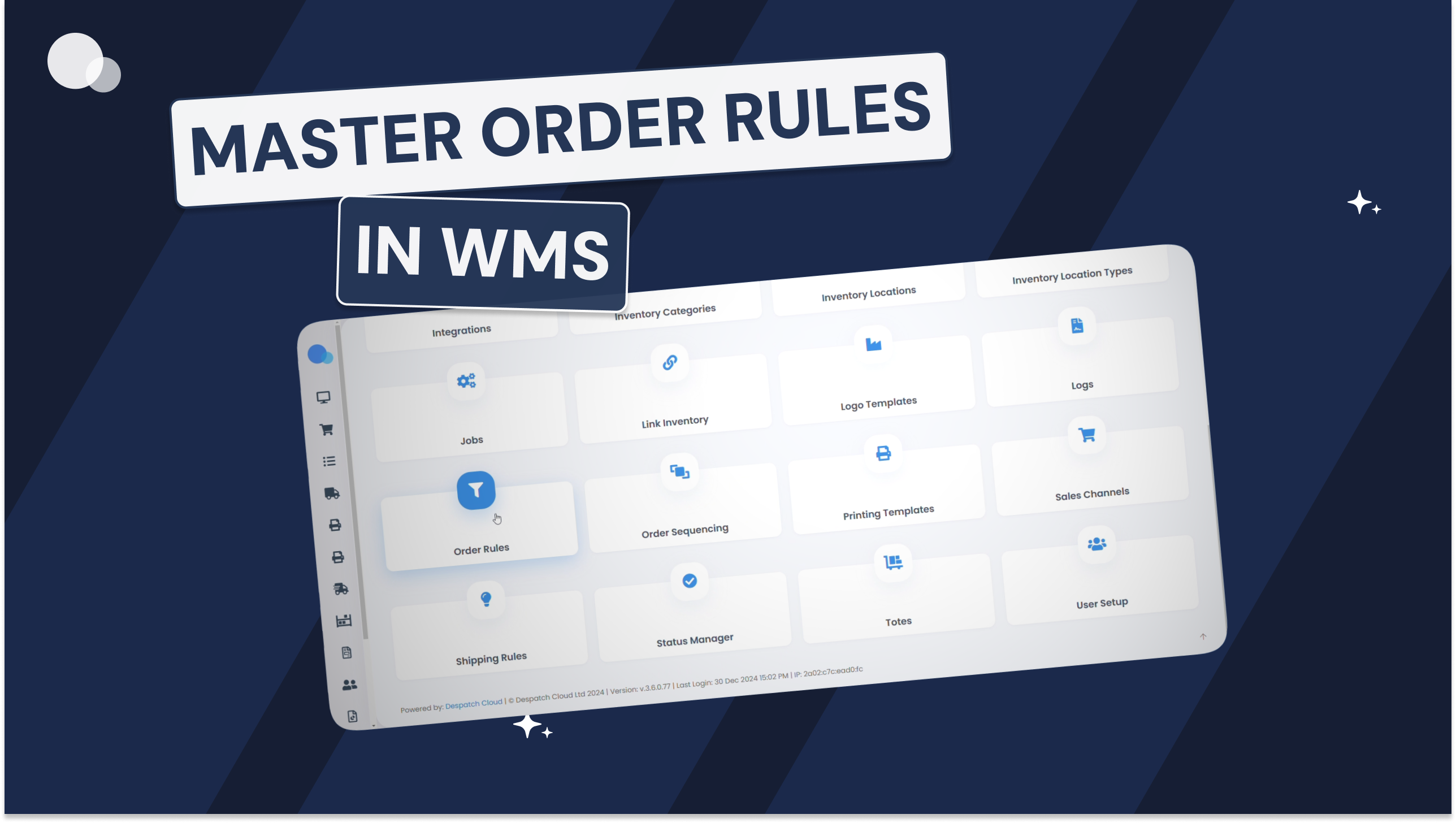Warehouse Efficiency: 10+ Underrated Ways to Improve Productivity
Want to provide an uplift in productivity and warehouse efficiency? Are you an online retailer exploring warehousing systems or aiming to boost your existing ones? Maybe you’re just starting, envisioning shelves filled with your products awaiting their journey to customers. Or perhaps you’re already knee-deep in the world of warehousing but are eager to increase efficiency within your existing operations. Whether you’re starting fresh or refining operations, this blog is for you.
Here, we explore the impact of warehouse management systems, address common challenges of warehouse optimisation, and unlock actionable tips for peak efficiency. Ready to dive in? Let’s roll.
Understanding Your WMS: Features and Capabilities
A Warehouse Management System serves as the powerhouse behind your day-to-day warehouse operations, offering a centralised suite of features and tools to promote efficiency. Let’s explore some key elements that contribute to a well-oiled warehouse:
- Real-time Inventory Visibility – Integrated Warehouse Management Systems (WMSs) gather inventory data from all your sales channels and update stock levels across the board as new orders come in. With real-time updates, businesses can ensure optimal inventory levels and consistency across sales channels and mitigate the risk of stockouts or overstock situations.
- Integration Capabilities – Seamless integration with other business systems, such as ERP and eCommerce platforms, is a hallmark of a powerful WMS. This integration ensures a cohesive flow of data across the entire business, preventing silos and enhancing overall efficiency.
- Barcode Scanning and RFID Technology – Leveraging barcode scanning and RFID technology, a WMS facilitates accurate and swift item identification. This not only accelerates the picking process but also minimises errors in product handling.
- Task Prioritisation and Resource Optimisation – WMSs intelligently prioritise tasks based on urgency and allocate resources to ensure that high-priority orders are fulfilled promptly, contributing to overall customer satisfaction.
- Performance Analytics and Reporting – The robust analytics tools embedded in a WMS provide valuable insights into warehouse performance. Businesses can track key metrics, identify bottlenecks, and make informed decisions to enhance overall efficiency.
- User-friendly Interface – A user-friendly interface is crucial for seamless WMS adoption. An intuitive dashboard allows users to navigate effortlessly, reducing the learning curve and promoting efficient use of the system.
- Dynamic Slotting – WMSs can intelligently assign storage locations based on product characteristics and demand patterns, ensuring efficient space utilisation.
By exploring and leveraging these key features, businesses can harness the full potential of their WMS, paving the way for a more efficient and agile warehouse operation.
Inventory Management Best Practices
Your WMS comes packed with tools tailored for efficient inventory management, offering a transformative approach to stock control. Techniques like cycle counting, ABC analysis, and SKU optimization work hand-in-hand to amplify your inventory efficiency. Here’s how:
Cycle counting, a method of regularly auditing a portion of inventory, ensures that discrepancies are identified and rectified promptly, minimising errors and inaccuracies.
ABC analysis categorises inventory items based on their importance or value, allowing you to prioritise resources and focus on the most critical items (A-items) while applying less rigorous control to less important items (C-items). This allows for more efficient allocation of resources and helps businesses optimise their inventory management strategies.
SKUs are unique identifiers assigned to each product in a company’s inventory. SKU optimisation involves analysing and refining the number and structure of SKUs to better meet the needs of the business. This can entail:
- Assessing the existing SKUs in the inventory to identify redundancies, slow-moving items, or obsolete products. By eliminating or consolidating underperforming SKUs, businesses can reduce inventory carrying costs and simplify management processes.
- Establishing consistent naming conventions, formatting, and numbering systems for SKUs to improve organisation and facilitate efficient tracking and management. Standardised SKUs make it easier to search, sort, and analyse inventory data.
- Grouping products into categories or hierarchies based on common attributes, such as product type, brand, size, colour, or seasonality.
- Leveraging technology, such as inventory management software or advanced analytics tools, to automate SKU optimisation processes and gain actionable insights into inventory performance. These tools can help identify opportunities for SKU consolidation, product bundling, or cross-selling to maximise sales and profitability.
By leveraging these techniques within your WMS, you can streamline inventory management processes, reduce stockouts and overstock situations, and ultimately improve overall operational efficiency.
Order Fulfilment Strategies
Warehouse Management Systems play a crucial role in streamlining order processing and enhancing fulfilment accuracy for eCommerce businesses.
By automating key processes such as order picking, packing, and shipping, WMSs minimize the potential for errors and delays in fulfilment operations. With real-time inventory visibility and tracking capabilities, WMSs ensure that the right products are picked from the correct locations and accurately packed for shipment.
Additionally, WMSs optimise order fulfilment workflows by intelligently prioritising tasks based on order urgency and resource availability, resulting in faster turnaround times and improved customer satisfaction.
WMSs also assist in generating the most efficient picking routes, contributing to shorter picking times and faster fulfilment, and increasing overall productivity in your warehouse. This process often includes mapping out your warehouse in the system and assigning priorities to your locations. Once this is done, your warehouse system will automatically generate the fastest route based on the products you need to pick for your orders.
Utilising Automation to Drive Efficiency
Automation plays a pivotal role in modern warehouse operations, revolutionising how tasks are performed and enhancing overall efficiency.
With a Warehouse Management System, businesses can leverage automation to streamline repetitive tasks, significantly reducing manual labour and minimising the risk of errors.
For example, automated picking systems utilize technologies like pick-to-light or voice-directed picking to guide warehouse staff to the exact location of items, reducing picking errors and improving efficiency.
Automated replenishment systems can monitor inventory levels in real-time and automatically trigger replenishment orders when stock levels fall below a certain threshold, ensuring optimal stock levels without manual intervention.
Additionally, automated barcode or RFID scanning systems can capture data on inbound and outbound shipments, providing instant visibility into inventory movements and enabling timely decision-making based on accurate data.
By automating processes such as inventory tracking, order processing, and replenishment, WMSs help optimise workflow efficiency and ensure consistent performance across warehouse operations.
Enhancing Communication and Collaboration with Warehouse Management Systems
Warehouse Management Systems can also help better collaboration among warehouse staff by facilitating seamless communication and information sharing.
With real-time data sharing capabilities, your WMS ensures that all team members have access to up-to-date information on inventory levels, order statuses, and warehouse activities. This eliminates the need for manual communication methods like phone calls or emails, streamlining communication and reducing the risk of errors or miscommunication.
Not only that. System integrations with other business systems such as Enterprise Resource Planning (ERP) or Customer Relationship Management (CRM) platforms enhance collaboration by providing a centralized platform for data management and sharing. By integrating your WMS with these systems, warehouse staff can easily access relevant information from different departments, enabling them to make informed decisions and coordinate tasks more effectively.
Overall, your WMS serves as a catalyst for improved collaboration among warehouse staff, enabling them to work together more efficiently and achieve common goals.
Warehouse Management Systems – Performance Monitoring and Analytics
Warehouse Management Systems capture data in real-time, providing updated information on inventory levels, order status, and warehouse activities. These systems also track key performance indicators (KPIs) such as order processing times, picking accuracy, and inventory turnover rates, and use historical data to forecast future trends, allowing businesses to anticipate demand fluctuations and plan accordingly.
Additionally, by analysing data on workflow processes and resource utilisation, WMSs identify inefficiencies and areas for improvement. These include:
Inventory Visibility: A WMS provides real-time visibility into stock levels, helping businesses identify slow-moving inventory that may need to be discounted or repositioned.
Order Fulfilment: Through performance metrics, a WMS can highlight bottlenecks in the order fulfilment process, such as inefficient picking routes or packing procedures.
Demand Forecasting: By analysing historical sales data, a WMS can predict future demand for products, enabling businesses to adjust inventory levels and prevent stockouts or overstock situations.
Resource Allocation: WMSs analyse data on labour and equipment usage to optimise resource allocation, ensuring that staffing levels and equipment utilisation are aligned with operational needs.
Overall, these data-driven insights empower businesses to make informed decisions, improve operational efficiency, and deliver better customer experiences.
Employee Training and Adoption
Training your workforce to fully utilise the WMS is crucial to maximising its benefits. A well-trained team not only ensures smooth system operation but also enhances efficiency and accuracy in warehouse operations. Providing comprehensive training sessions tailored to different roles and responsibilities within the warehouse equips employees with the necessary skills to navigate the system effectively. Additionally, hands-on training sessions, supplemented by user manuals and online resources, can familiarize staff with the WMS functionalities and best practices.
Fostering a culture of continuous learning is also essential for adapting to new technologies and evolving warehouse processes. Encouraging employees to engage in ongoing training programs and professional development opportunities keeps their skills sharp and ensures they stay up to date with advancements in WMS technology. Additionally, soliciting feedback from staff about their experiences with the system and addressing any challenges or areas for improvement can foster a collaborative environment focused on optimising WMS utilisation for enhanced warehouse efficiency.
How Despatch Cloud Helps You Make the Most of Your WMS
Despatch Cloud’s Warehousing solution is specially designed to empower businesses and help them maximise the potential of their Warehouse Management System.
With a suite of features built for streamlined inventory management, order processing, and operational efficiency, Despatch Cloud offers users an easy and cost-effective way for retailers to stay competitive in the dynamic eCommerce logistics landscape.
One keyway Despatch Cloud facilitates efficient WMS utilisation is through seamless integration with various sales channels and eCommerce platforms. By pulling stock data from all online stores and syncing inventory levels across channels, Despatch Cloud ensures accurate and up-to-date inventory management. This integration removes one of the most complex and time-consuming aspects of inventory management, allowing businesses to meet customer demands promptly and accurately.
Despatch Cloud’s intuitive user interface and user-friendly dashboard make it easy for warehouse staff to navigate the system and access critical information swiftly. Through automation of repetitive tasks and real-time data capture, Despatch Cloud enables informed decision-making and continuous operational improvement.
Additionally, Despatch Cloud has a dedicated onboarding team for new Warehousing users, as well as easy-to-follow step-by-step guides, ensuring that businesses can fully harness the capabilities of their WMS for optimal warehouse performance.
Unleashing the Full Potential of your Warehouse Management System
In summary, optimising warehouse efficiency through a Warehouse Management System (WMS) like Despatch Cloud is crucial for staying competitive in today’s logistics landscape.
By leveraging the features of a WMS, businesses can streamline operations and gain valuable insights for informed decision-making. Prioritising workforce training and embracing the full potential of the WMS are essential steps towards success.
With solutions like Despatch Cloud’s, businesses can unlock the full benefits of their WMS and thrive in the dynamic eCommerce environment.






